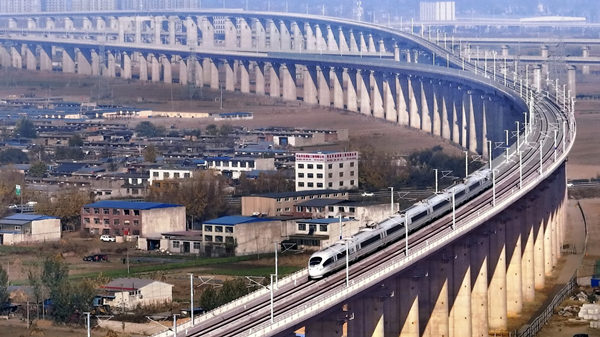Coordinated development improves lives, environment

A high-speed train of the Beijing-Tangshan Intercity Railway crosses a bridge in Tangshan, Hebei province. [Photo by Liu Quanguo/For chinadaily.com.cn]
At 6:15 one Friday morning, He Peng stood in line at Zhuozhou East Railway Station in Zhuozhou, Hebei province.
The 43-year-old was on his way to Beijing for work. His train leaves at 6:23 and arrives at Beijing West Railway Station 24 minutes later.
"Such an early high-speed train is really convenient for my daily commute," he said.
He has commuted for 10 years, but it was only after trains for intercity commuters went into operation in July last year that he started to feel the coordinated development of the Beijing-Tianjin-Hebei region is benefiting ordinary people like him.
This year is the 9th anniversary of the initiation of a key strategy to coordinate the development of Beijing, Tianjin and Hebei province — a regional urban economic cluster in North China.
Over the past nine years, coordination of the region has yielded remarkable results, especially in terms of traffic integration, economic development, industrial upgrading and environmental improvement.
By the end of last year, there were 10,848 kilometers of railway lines in operation in the region, up 38.3 percent from 2014, according to the Beijing Bureau of Statistics.
From major cities within a 300-km radius of the capital, including Tianjin, Shijiazhuang and Baoding, Beijing can be reached via high-speed train in under 1.5 hours.
From Tianjin to Beijing, there will be four high-speed lines to choose from this year, according to the Tianjin Transportation Commission.
"Transportation has created a solid foundation for the region's coordinated development," said Zhao Tongan, deputy head of the Hebei Provincial Department of Transport.
The core areas of Beijing, Tianjin and the Xiong'an New Area — a new economic area in Hebei — are accessible each within half an hour, he said.
One prominent task of the integration strategy is to transfer nonessential capital functions out of Beijing to help treat urban ills like traffic jams.
Last year, Tianjin received an investment of 198 billion yuan ($28.6 billion) from Beijing and Hebei, while some 4,000 companies and institutions from Beijing and Tianjin resettled in Hebei, the Beijing Bureau of Statistics reported.
Since 2014, some 40,000 business units have resettled to the province, mainly from the capital.
Efforts to promote industrial transfers have also contributed to the region's booming economy.
The Beijing-Tianjin-Hebei region had a combined GDP of 10 trillion yuan last year, with Beijing and Hebei accounting for 4.2 trillion yuan each, and Tianjin 1.6 trillion yuan.
The coordinated development of the region has also created a better environment for its inhabitants.
Data showed that the annual PM2.5 density — a major gauge of air pollution — decreased by 60 percent between 2013 and 2022 in Hebei, according to the province's department of ecology and environment.
"I've been able to see more blue sky at home in recent years. That's a really good thing because it makes us happier," said Wang Ruchun, a photographer from Shijiazhuang who has been taking daily photos to record air quality since 2014.

Copyright ©
Tianjin Municipal Government. All rights reserved. Presented by China Daily.
京ICP备13028878号-35

